Set pieces are becoming increasingly important, attracting the attention of coaches, analysts and fans worldwide.
This has led to the emergence of several concepts related to blocking or hindering the opponent: the “block” and the “screen”.
Here, we define each term:
1) The block involves an attacking player positioning himself to block a defender, such as a zonal defender, to prevent him from getting out to reach the ball in the targeted area; it can also involve blocking the goalkeeper to stop him from claiming the ball before it reaches the target area or to delay his reaction.
2) The screen involves an attacking player obstructing, or at least disrupting, the man marker assigned to the targeted player to free him, similar to what occurs in basketball.
This previous article was an analysis to discuss the block in both forms: the zonal defender and the goalkeeper.
This article will explore the screen and how to do this effectively without fouling.
As a coach or analyst, you may have asked one of your players to perform a screen, only to fail and allow the defender to escape.
Alternatively, the screen might have been too obvious, resulting in a foul being called, especially since referees have started to show greater strictness regarding this issue.
These steps are very important, especially since we don’t all play in the Premier League, where more conflicts are allowed.
Referees have even become more aware of this trick in the Premier League.
In this tactical analysis, we will discuss the various techniques and strategies for executing the screen effectively while simultaneously avoiding fouls.
The Normal Screen In Set-Pieces
The usual screen is done by asking a player to go directly to disrupt the man marker of the targeted player.
Germany did that in the previous Euros against Denmark, leading to a goal being disallowed.
The obvious screen caused a foul.
As shown below, Nico Schlotterbeck (blue) is marked, so Joshua Kimmich (green) goes to block his marker to free him.
This is a screen.
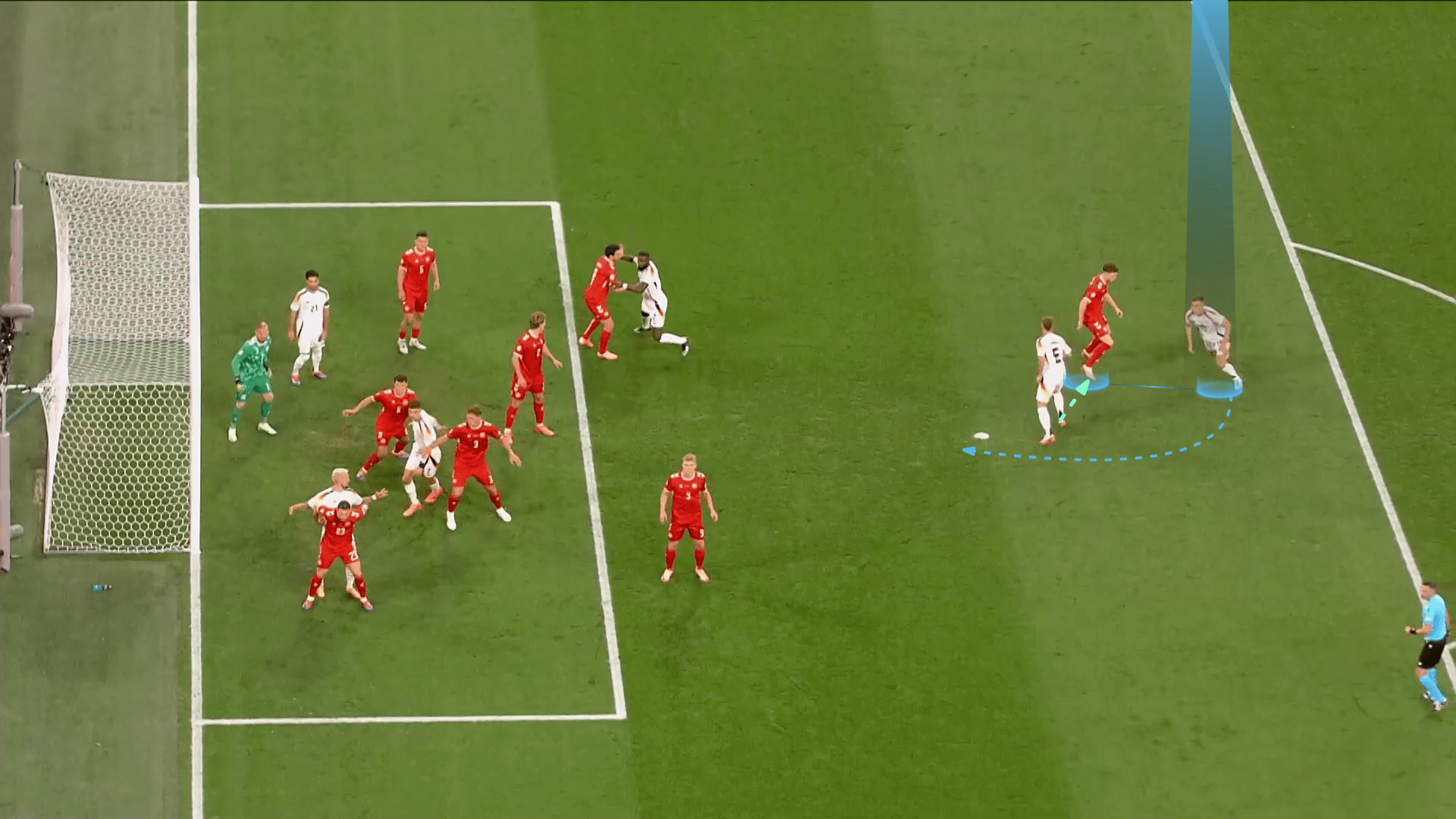
In the photo below, the screen performs well, but it is so obvious that it is called a foul.
This is what we mean when we say the screen can only be effective if done subtly, avoiding a foul.
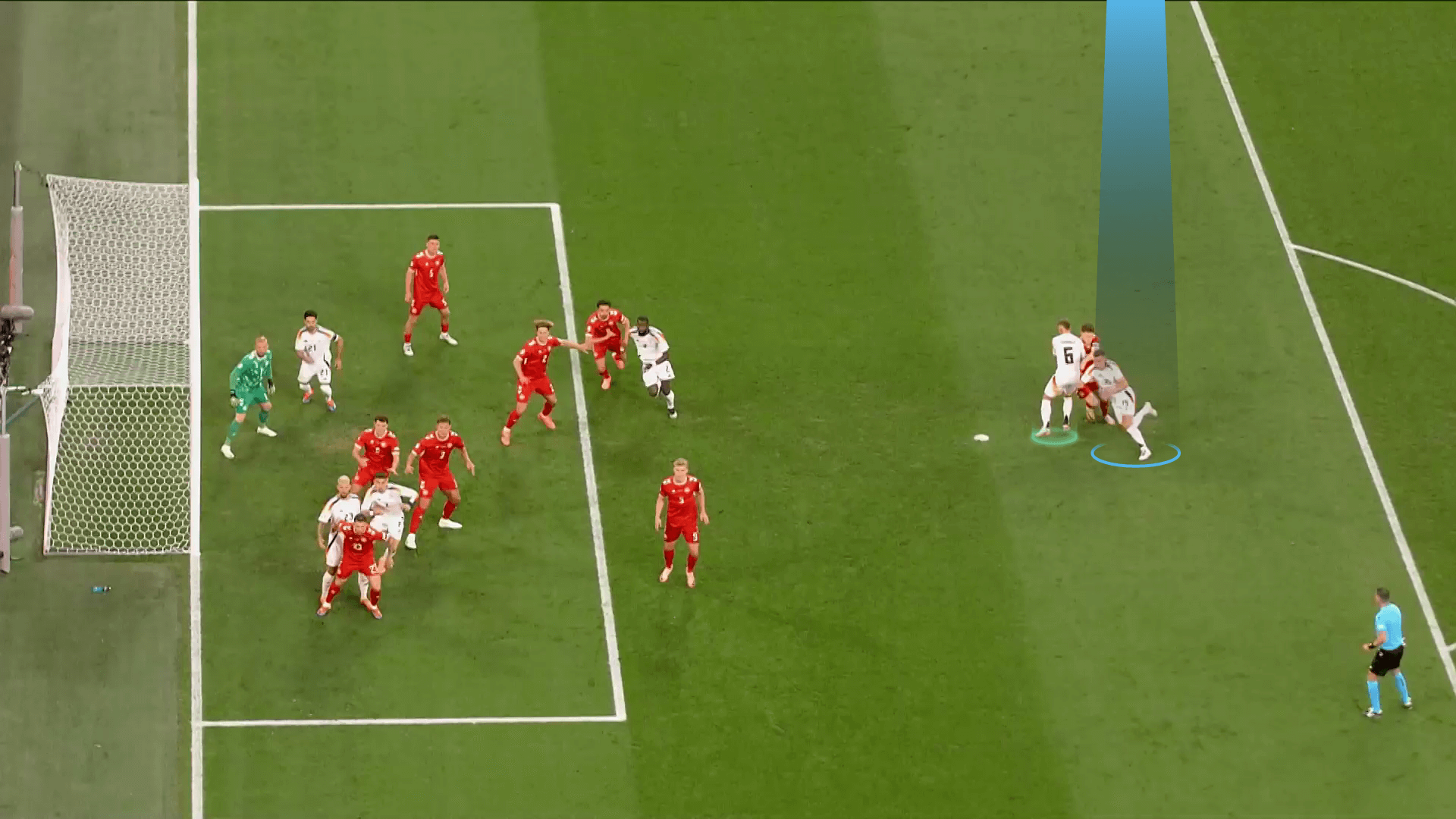
Separation In Set-Pieces
The first trick we will discuss is making the targeted player run around the teammate who will do the screen.
This makes it easier because it causes a separation between the targeted player and his marker.
His teammate is just asked to disrupt or slow down the marker with small steps, not facing him directly.
Let’s clarify that with an example from Germany.
As shown below, the targeted player (blue) suddenly runs around his teammate as the taker moves or gives the sign, while the man marker finds himself forced to follow him through his teammate (green).
This puts the marker against two choices: Running behind the targeted player, which makes it easier for the green teammate to stand in his path, or taking the other way, running behind his own teammate, which causes a separation between him and the attacker, which is what happened.
In this case, a separation between the targeted player and his marker is achieved, so the green teammate is asked to push his marker just a step forward to cut the path of the target player’s marker.
Even if he couldn’t prevent him totally from following, the target player was separated for enough time to run freely and gain good momentum.
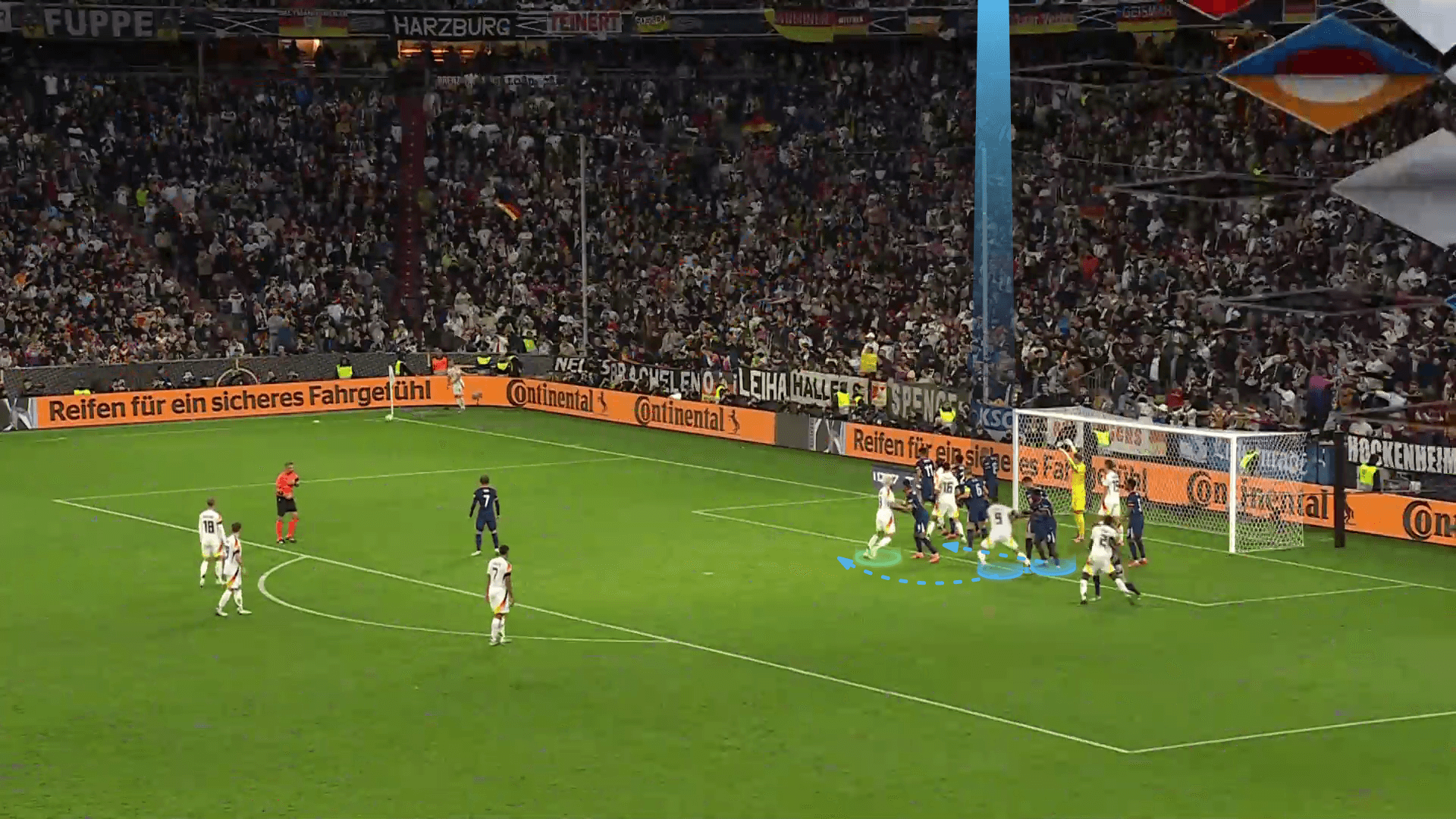
As shown below, the screen succeeds, so the attacker gets free while the referee can’t call a foul because it seems that the marker is the one who goes to the green teammate who normally stands in his position.
An advanced note: The green teammate turns around to give his back to his own man marker to prevent him from leaving him for the targeted player after realising the trick.
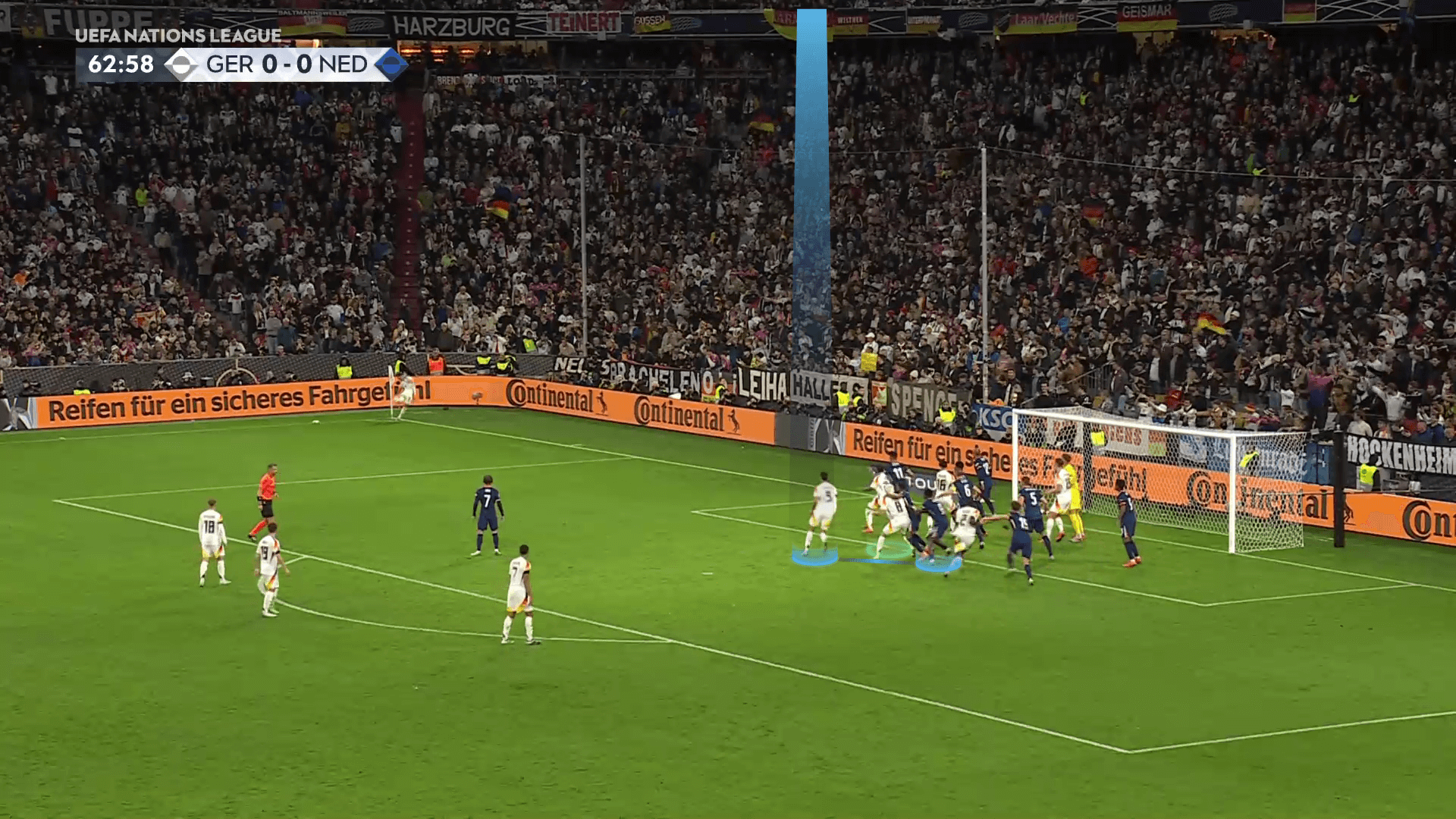
Mexico also had a similar idea, placing the two teammates closer to each other.
In the first photo below, the defending team uses a man-marking system using only two zonal defenders: a short-option defender, a player standing forward for counterattacks, a player standing on the edge of the box, and five-man markers.
To simplify the issue, they target the black area with the yellow player, but there are two problems: the zonal defender and the man marker of this targeted player.
In the second photo, the blue attacker goes to the zonal defender to block him.
At the same time, the targeted player moves around his orange teammate, using him to screen his marker, which is already done in the third photo, in which an attacker moves to the far post to frame the goal.
In contrast, his marker turns around to track him, losing communication with the ball.
The plan is done in the fourth photo, with the block and the screen in blue and orange, respectively.
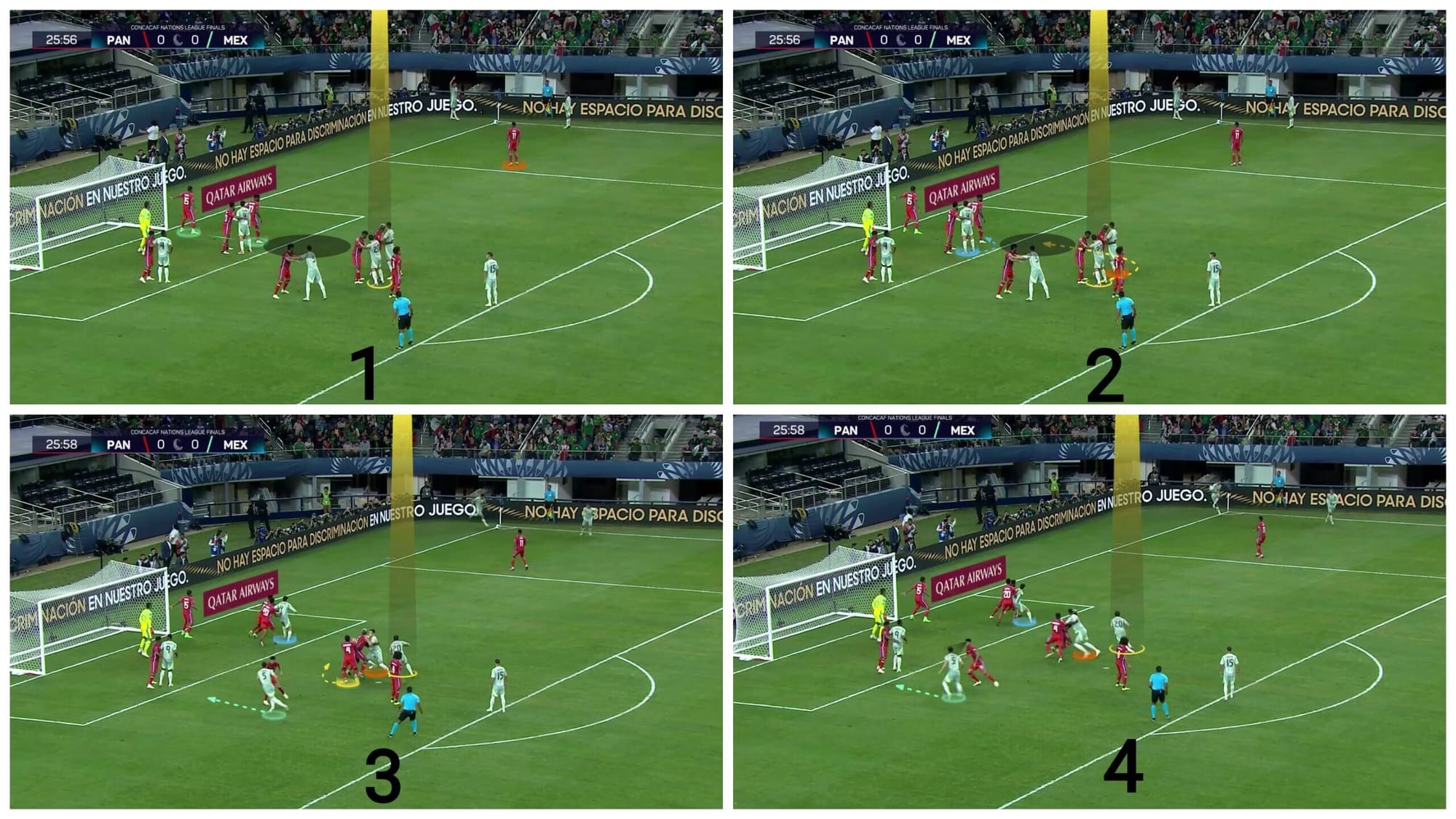
The plan to free the yellow player succeeded, as in the photo below.
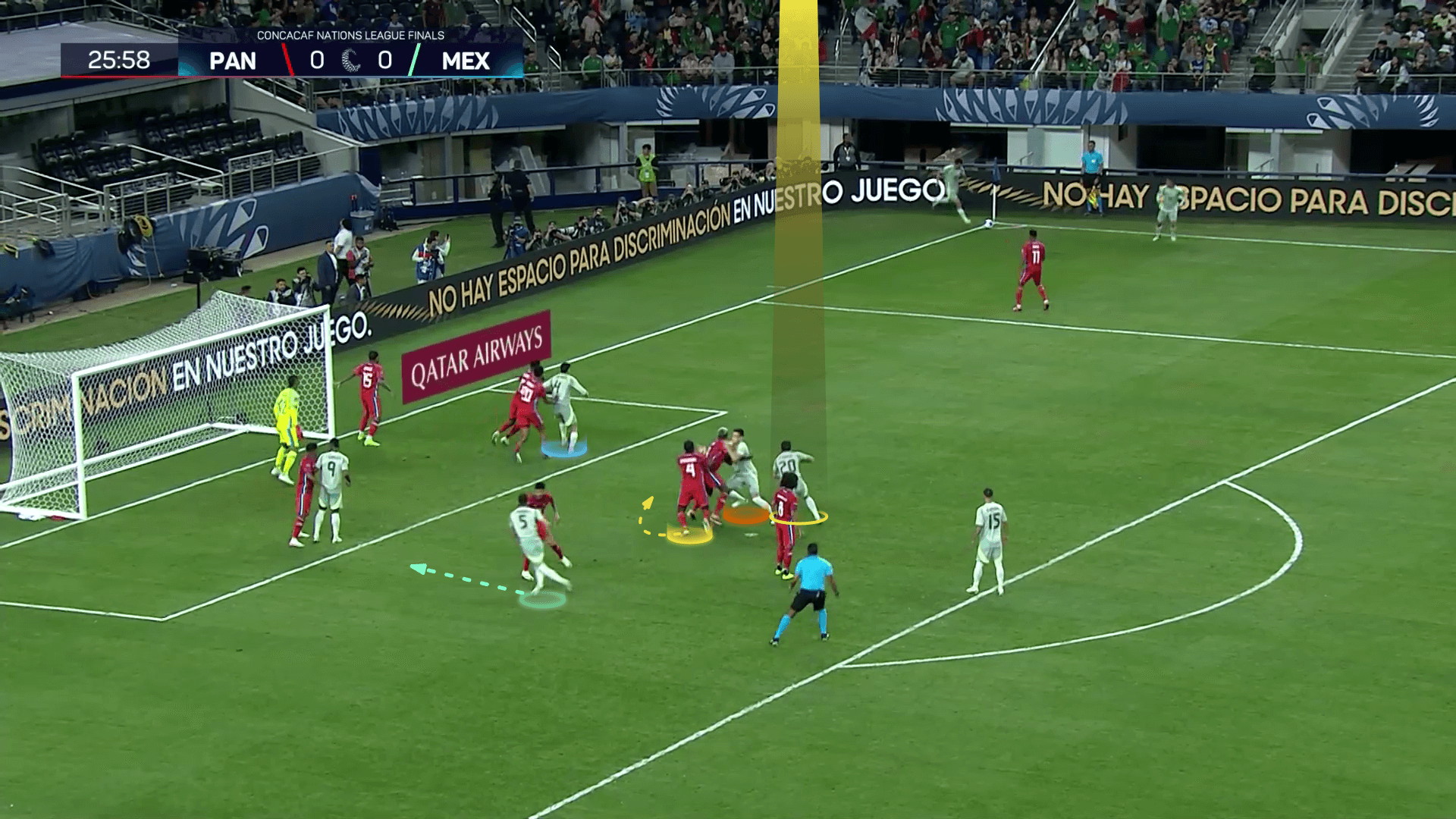
Orientation Problems In Set-Pieces
In the next photo, Man City faces Crystal Palace, which uses a man-marking system with only two zonal markers (white).
Man City used a similar idea to target Rodri (yellow), asking him to run around his two teammates, Joško Gvardiol (pink) and Nathan Aké (green).
Gvardiol will do the screen to free Rodri while Aké blocks his teammate to prevent him from going to Rodri after realising the idea.
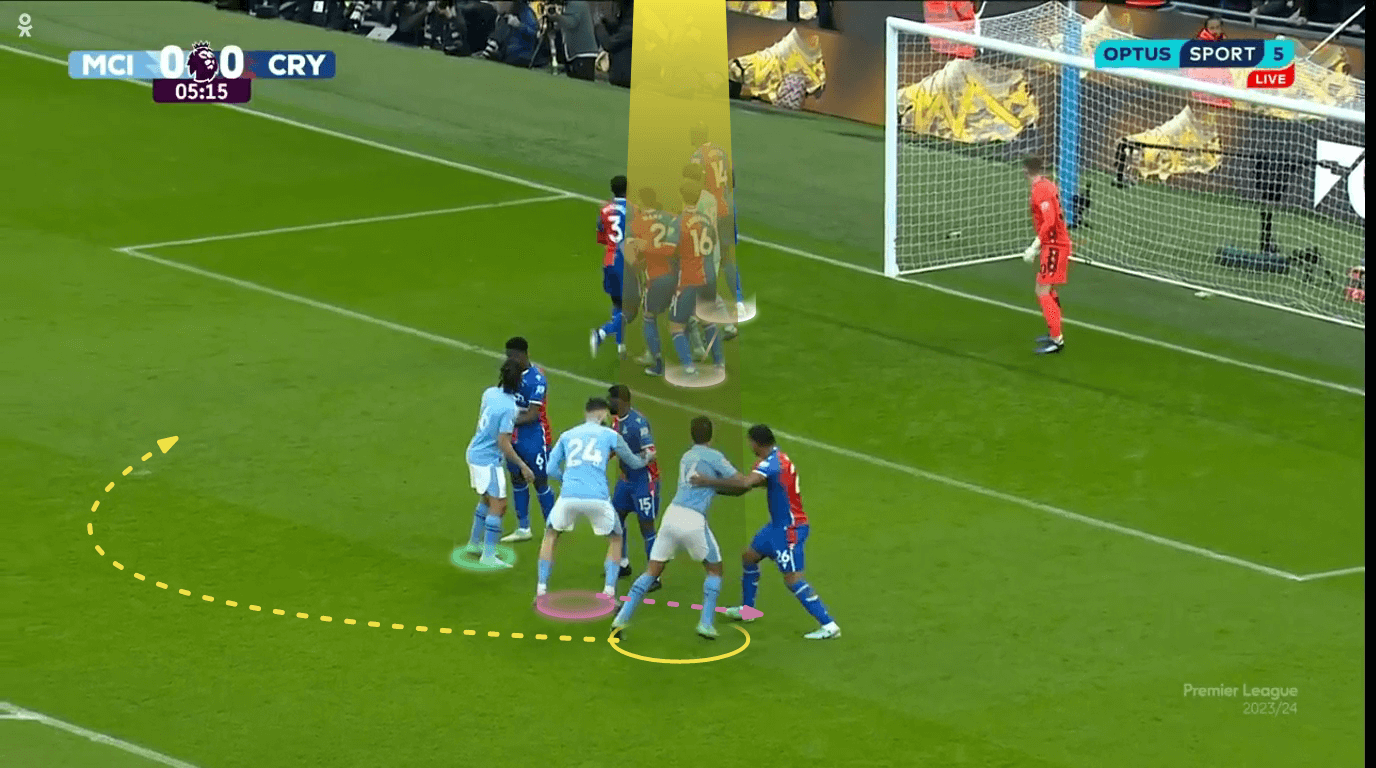
As in the two photos below, Gvardiol does the screen perfectly while Aké, in green, blocks his marker, ensuring he won’t leave him to go to Rodri if he realises the trick.
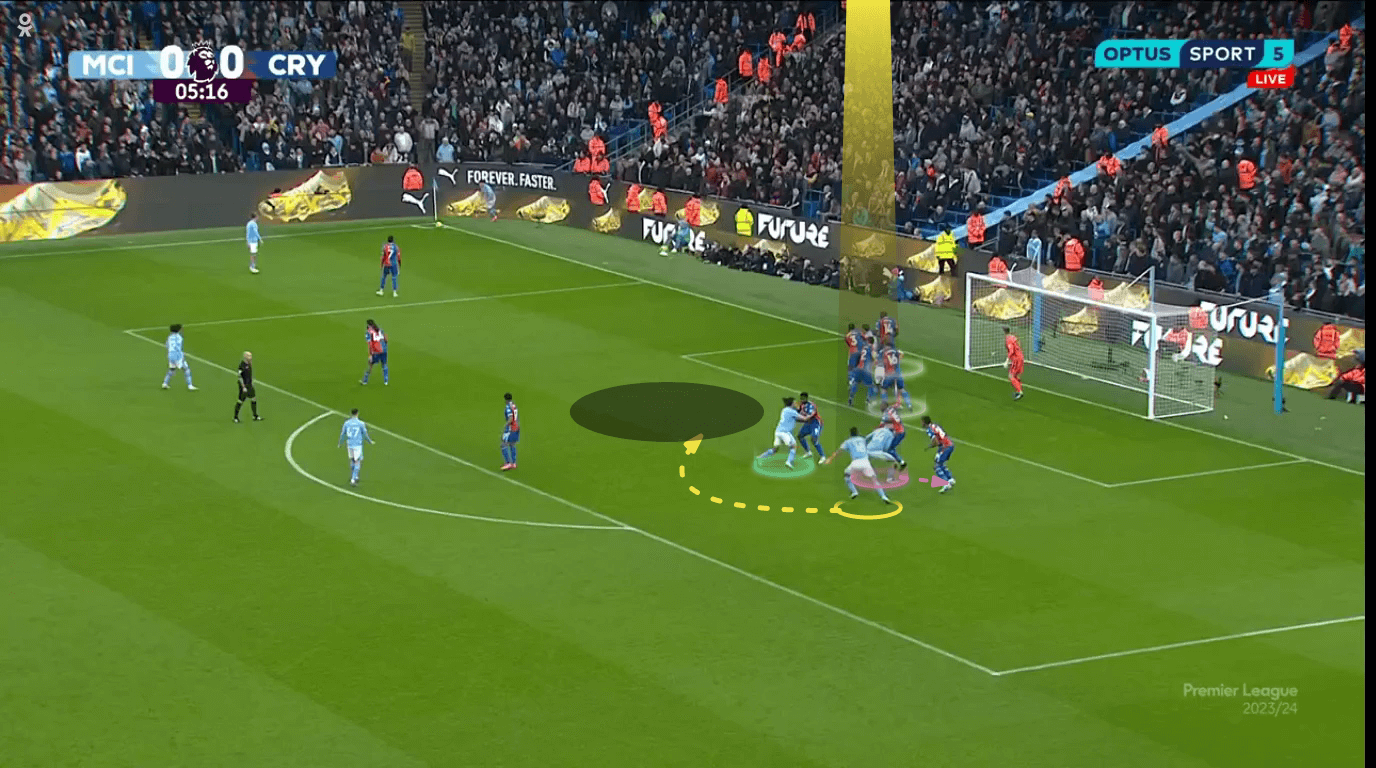
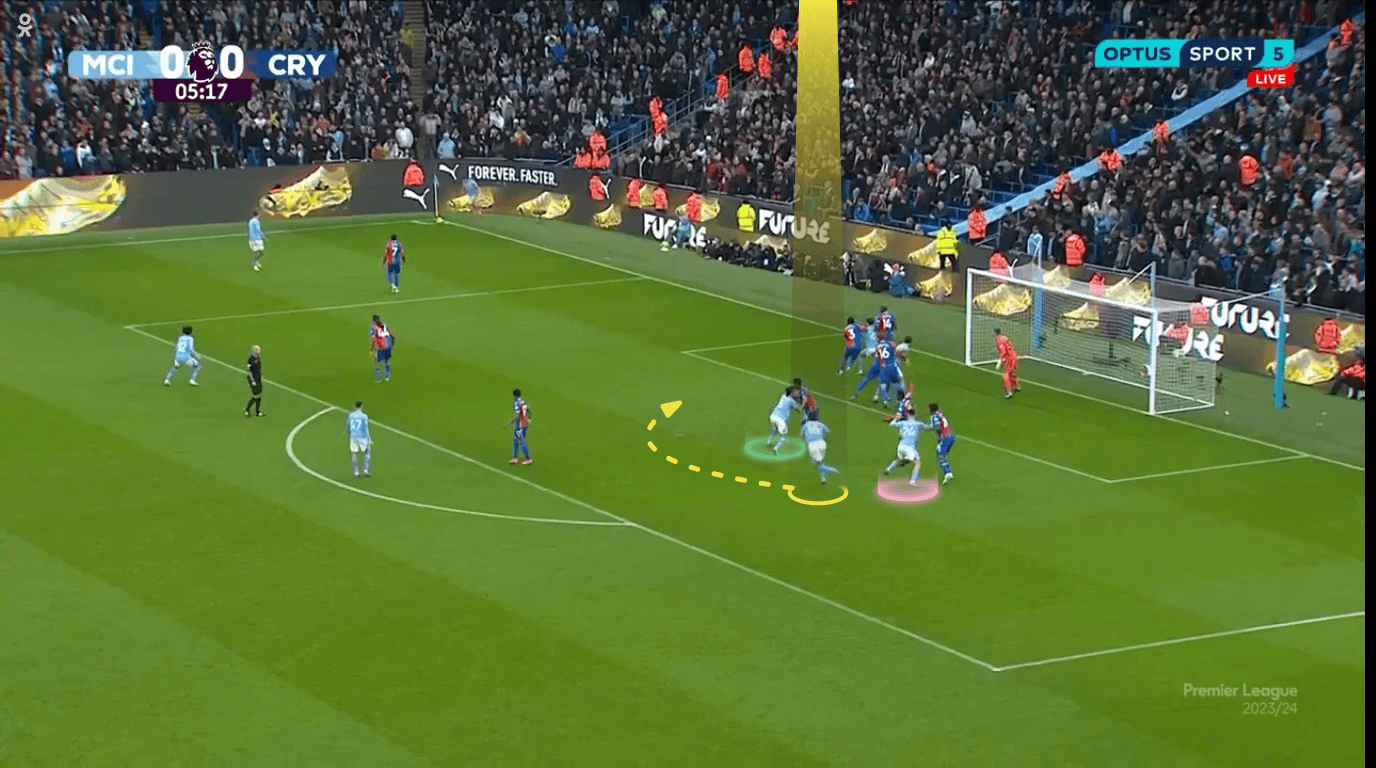
But he realised the trick and pushed him to chase the target player (Rodri) because he saw the ball and all the movements necessary to perform the trick in front of his eyes.
The weakness of this method is that one of the other markers can decide to leave his assigned attacker to chase the targeted player after realising the trick, as Aké’s marker did here.
This is especially true since all these movements happen in front of their eyes for a long time, which makes it hard for the attackers to keep blocking the defenders all that time.
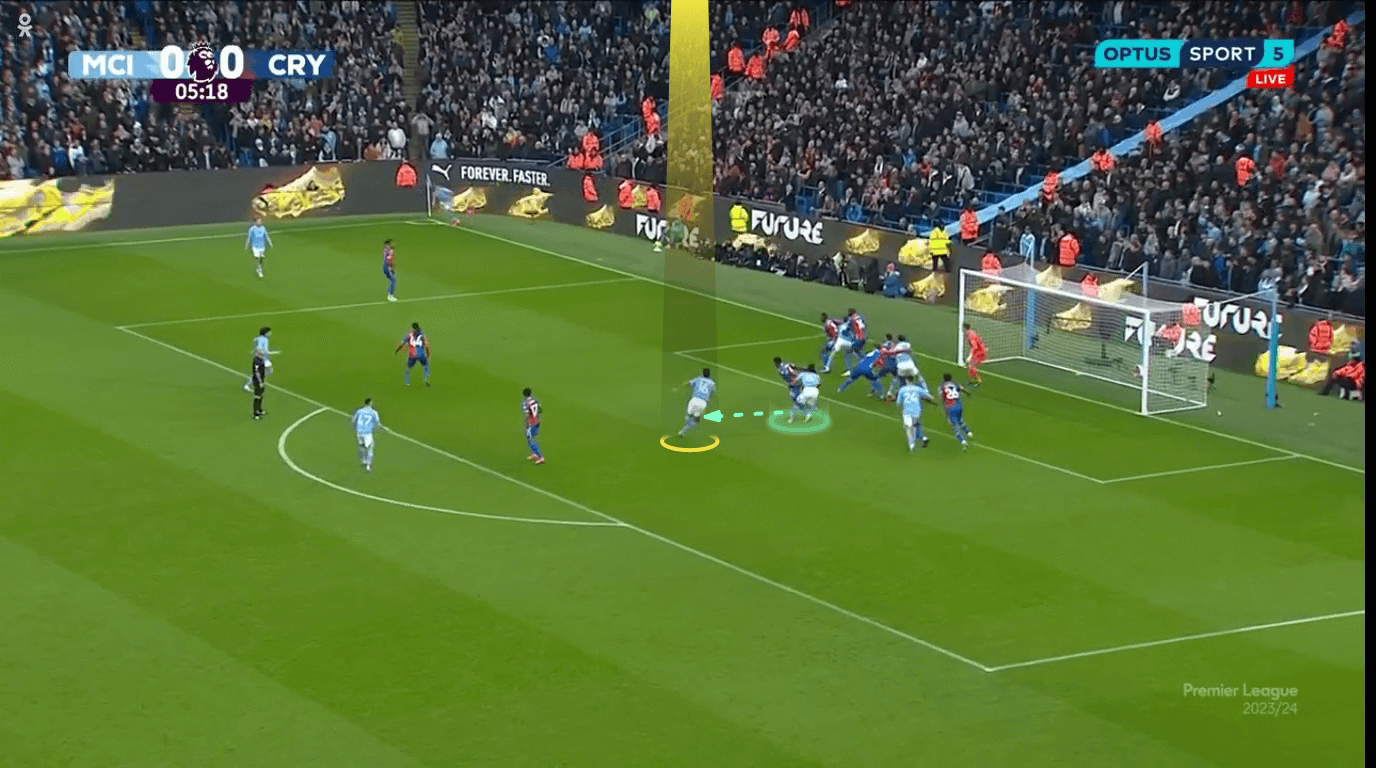
In the following corner, Man City planned to target the far post, and I want you to notice the big difference caused by the markers’ orientation problems.
Causing orientation problems for a marker means making it hard for him to keep track of the ball in the air and his attacker simultaneously.
As shown below, the change is evident by putting the group more toward the near post, making the target player, Nathan Aké, the first one from the near side and will move to the far post, not the opposite as in the previous case.
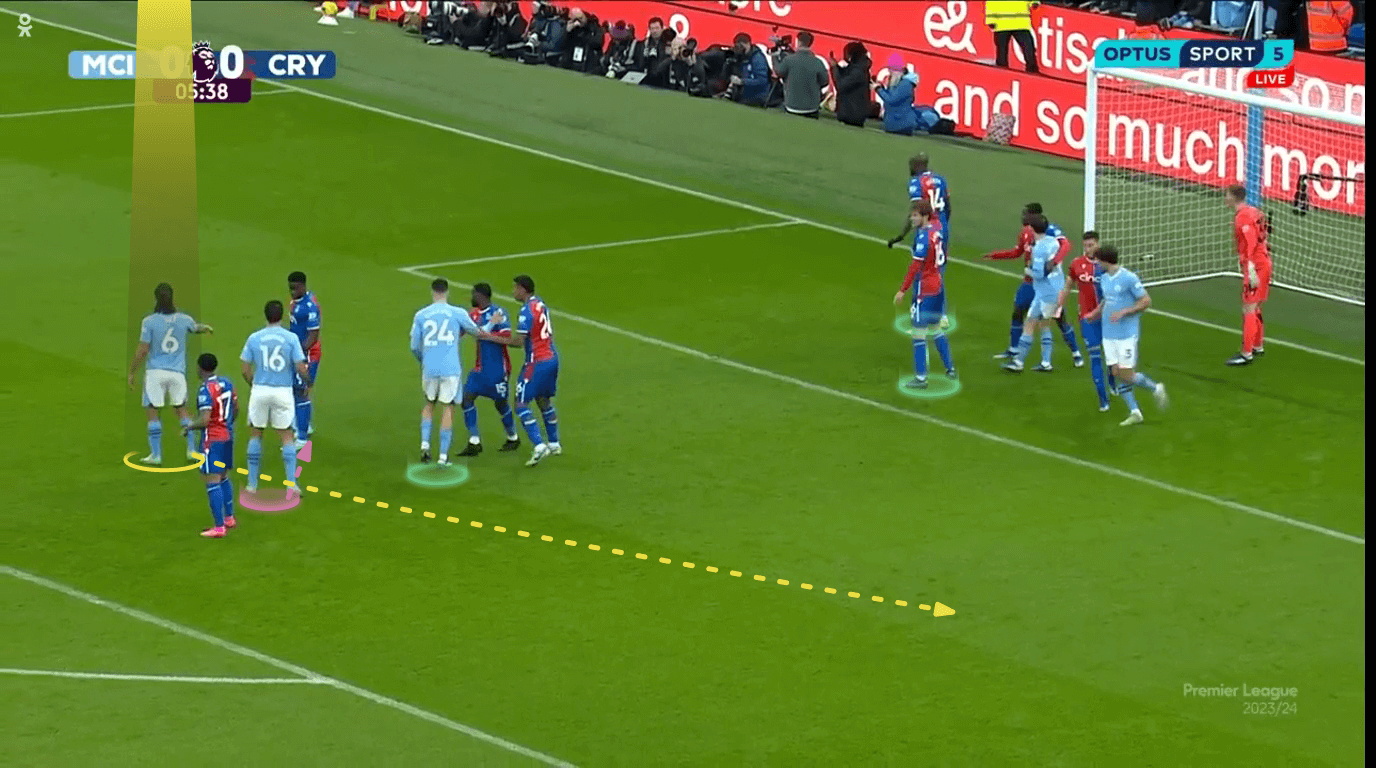
In this case, Rodri screens for his teammate, so when Aké makes his curved run, his marker will turn around, giving his back to the ball, losing contact with it, and also finding Rodri against him as he turns around.
Once the marker turns around, he finds Rodri at his face.
When he turns around, Rodri is standing in his position, meaning that it isn’t a foul.
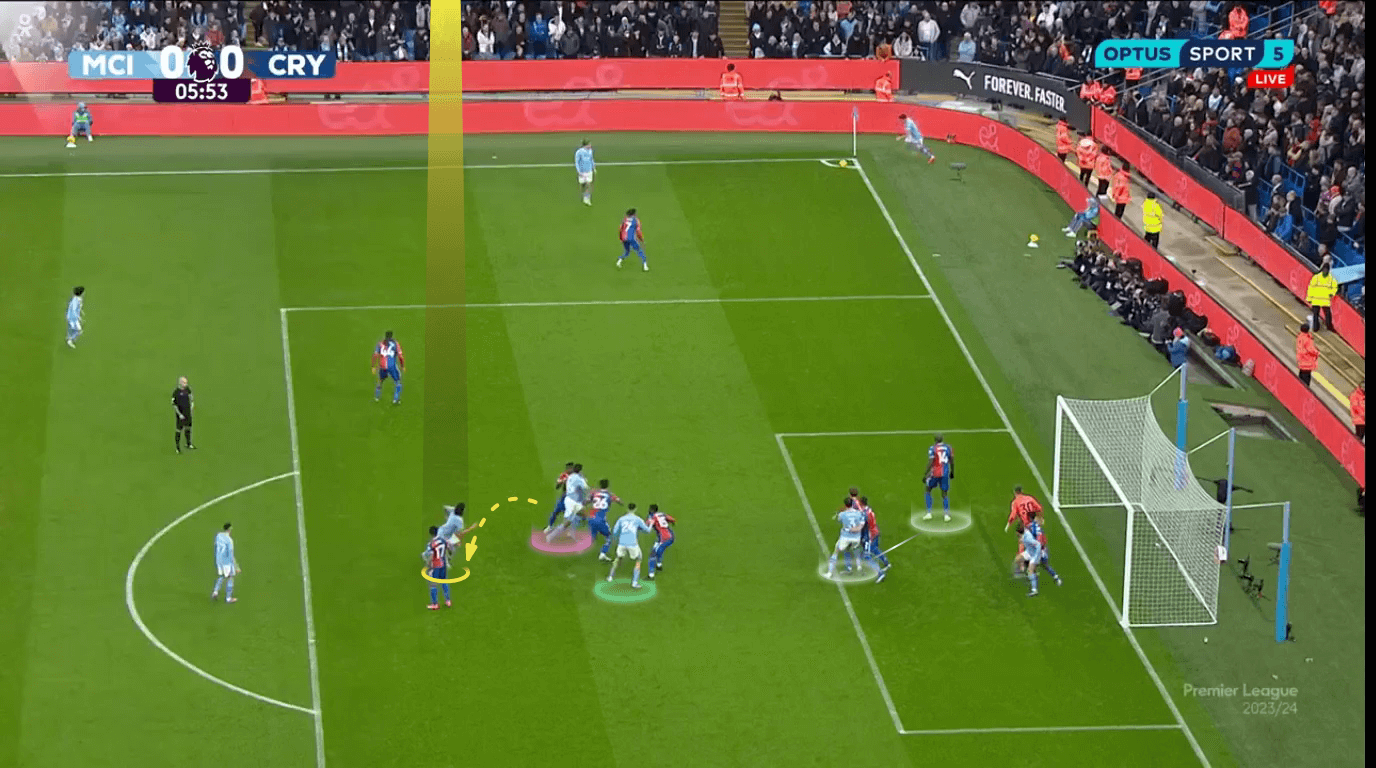
In the photo below, the main advantage is clear: the green man marker who cut the ball in the previous case needs to turn around to track the ball.
He will find the attacker in his back, preventing him.
If the target player’s marker can escape from Rodri, as has already happened, he will face orientation problems when tracking the target player back.
This is clear when he tries to look at the ball in the air and loses contact with the targeted player.
This means that Rodri is just asked to do the screen for a moment without making this process last for a long time.
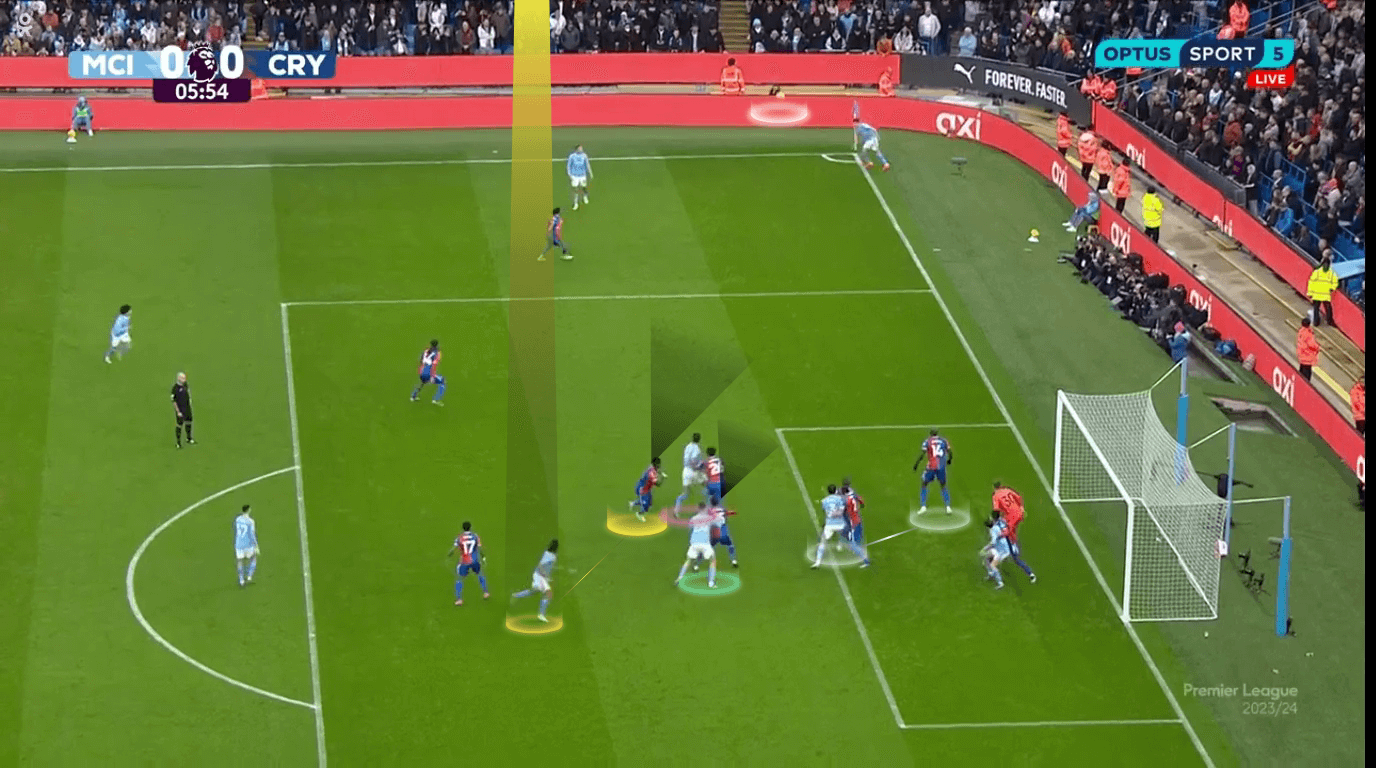
In the end, Aké gets the ball while his teammates frame the goal, waiting for the headed pass.
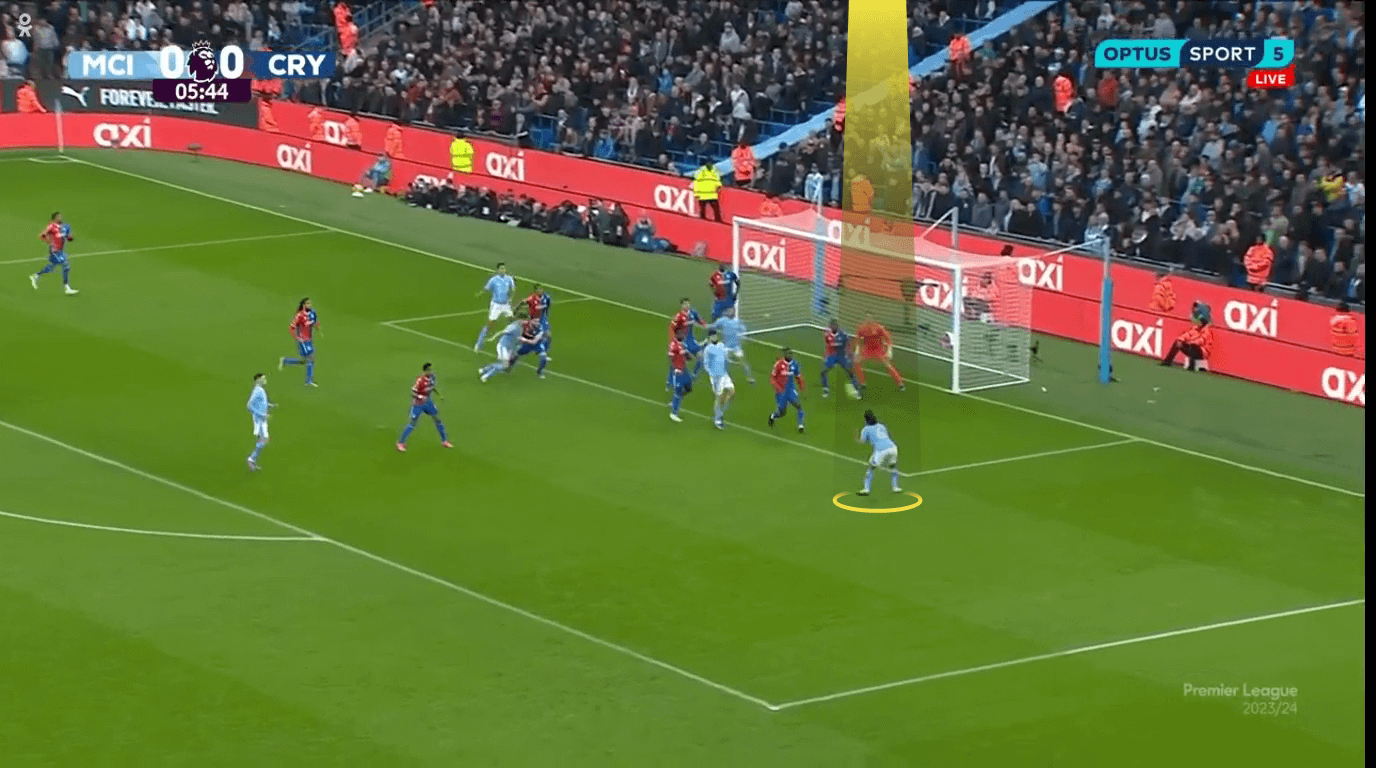
The ball reaches one of them and ends with a dangerous shot.
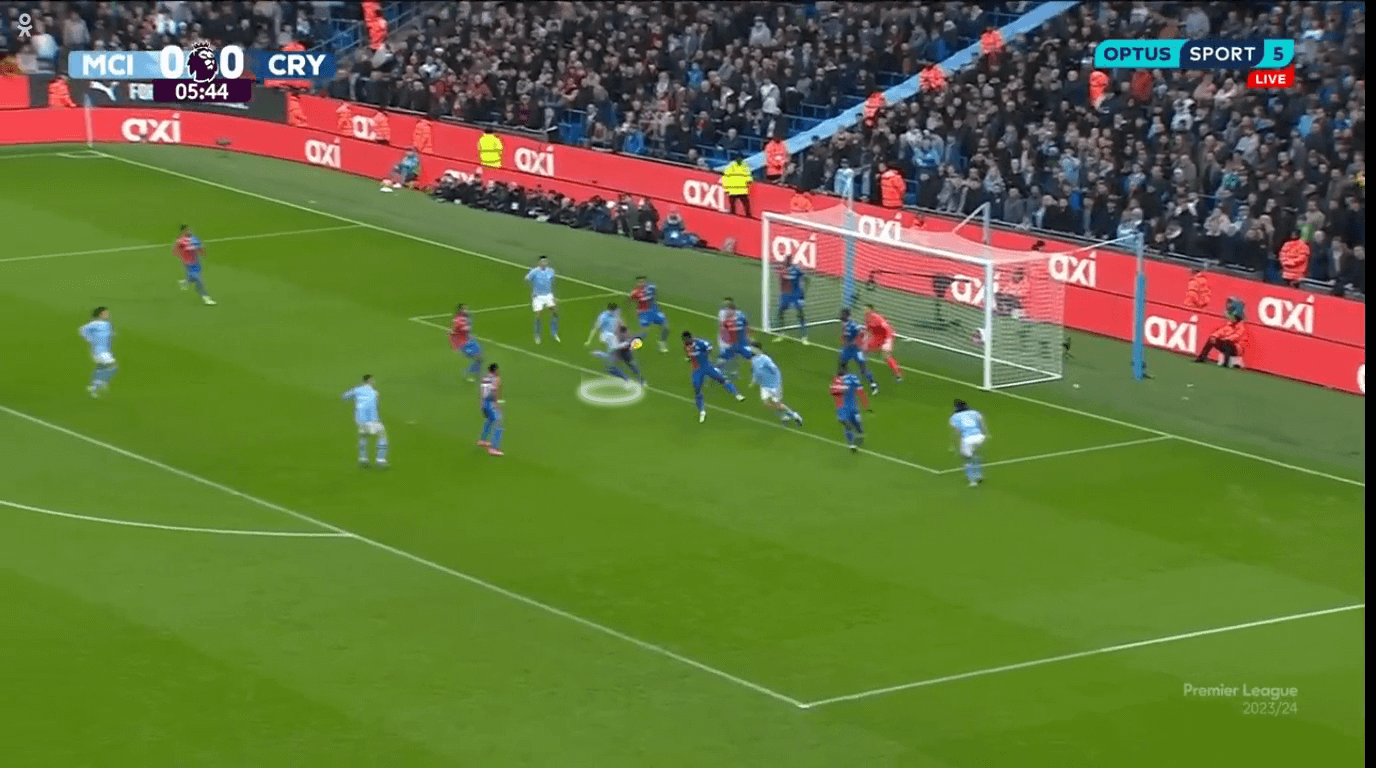
There are many other ways to cause orientation problems for the markers; starting in a far position is one of them because it makes it harder for the marker to keep tracking the ball and the attacker simultaneously.
Germany followed a similar idea to the previous one, supporting the same previous orientation problem with an additional tip, which is starting in a further position.
As shown below, the target player (baby blue) starts at a distance, dragging his man marker and running around his two teammates.
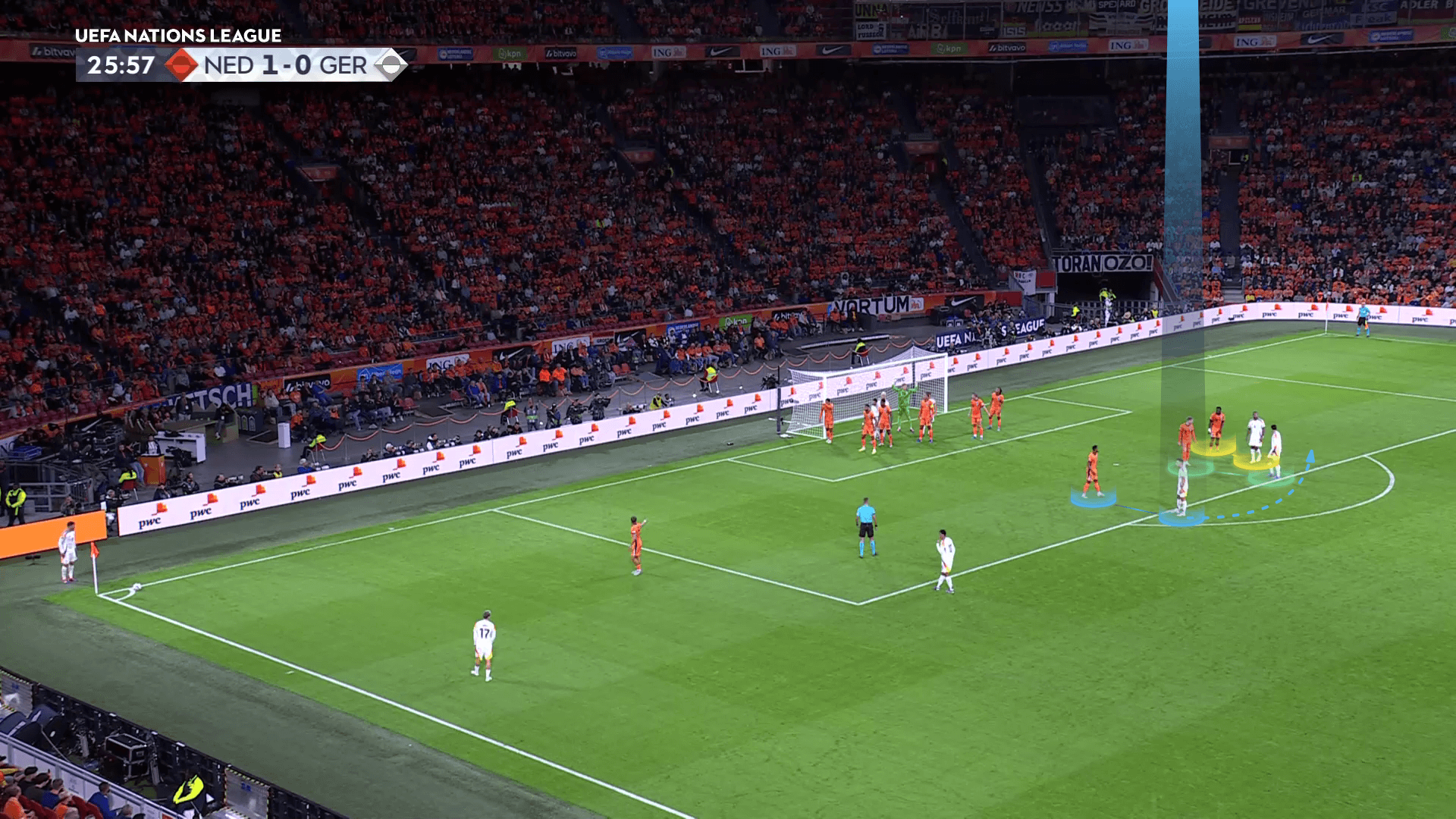
As shown below, his man marker is forced to choose between stepping back to keep looking at the ball or turning around to track the target player, giving his back to the ball.
In this case, the distance he should cut to track the targeted player is too long, so neglecting the ball all this time is not reasonable.
Still, if he takes a look, he will lose the target player, which puts him in a tough situation, like running without knowing the destination.
After that, the two teammates’ roles come normally, as in the previous case, and you can notice the green player can stand in his position to disrupt the marker, acting like he stands in his position and the marker is the one who comes for him to avoid fouls.
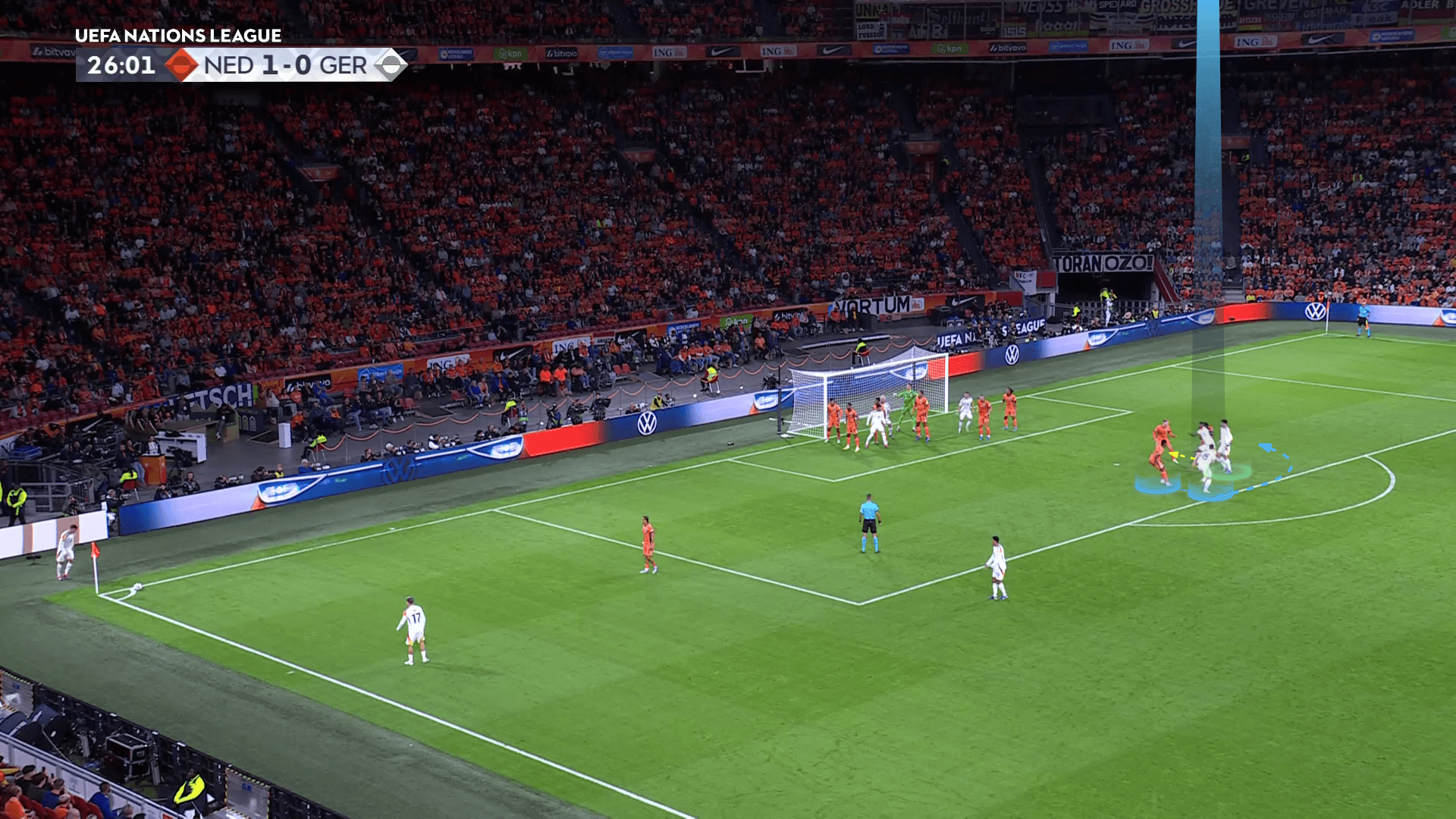
The plan works, and the targeted player becomes free, as shown below.
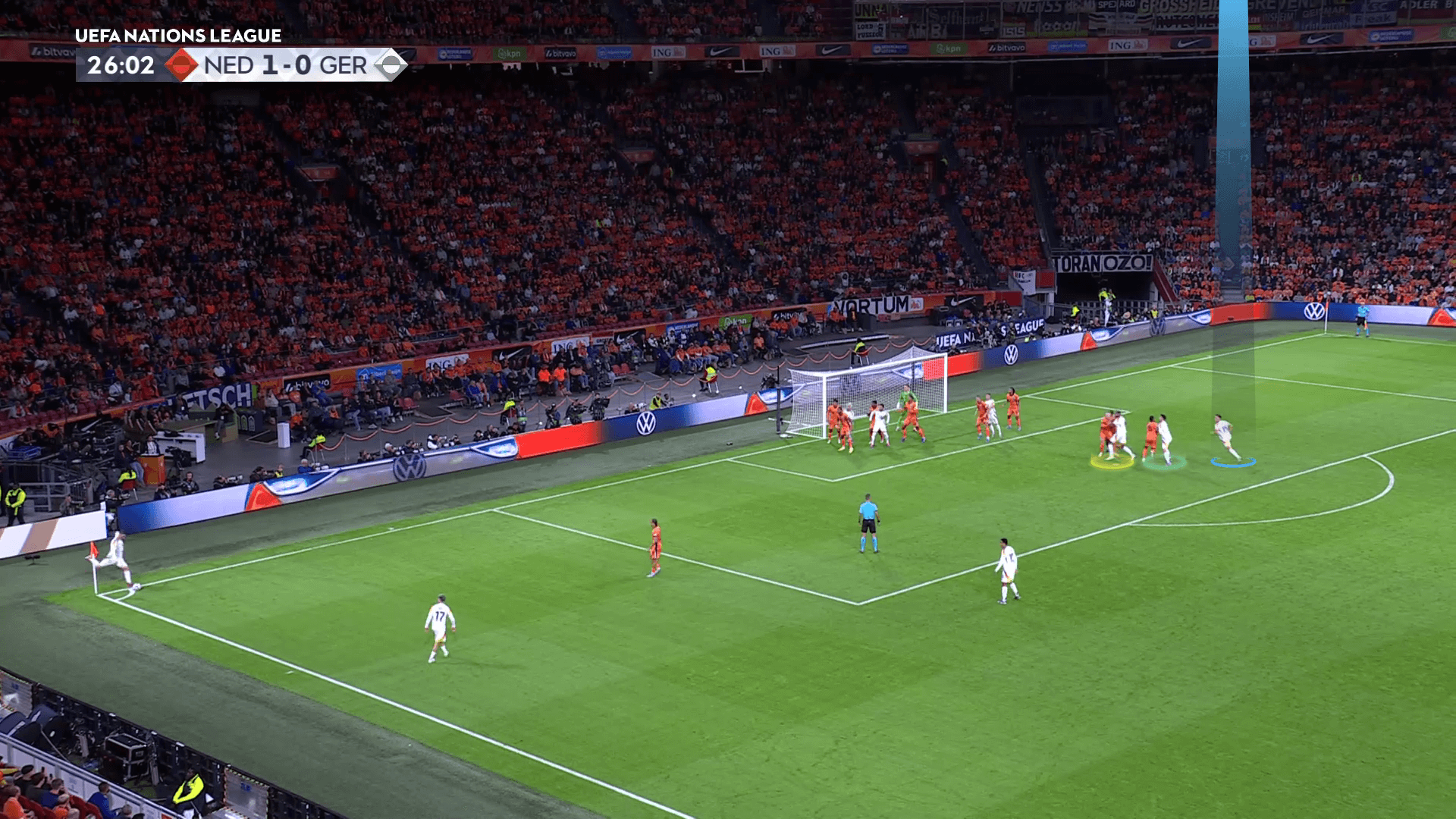
Traffic With A Big Pack & Orientation Problems
The next trick is asking the target player to start among a pack of his teammates — a group of players close to each other.
When he escapes from his marker, the marker will find himself trapped, confined, and besieged in his way to track the target player.
As shown below, Aston Villa defended with two zonal markers highlighted in green and six-man markers.
At the same time, Ashley Young, who stands on the edge of the six-yard box, was instructed to go forward to guard against a short corner if played, along with Leon Bailey, highlighted in yellow, to be in a 2v2.
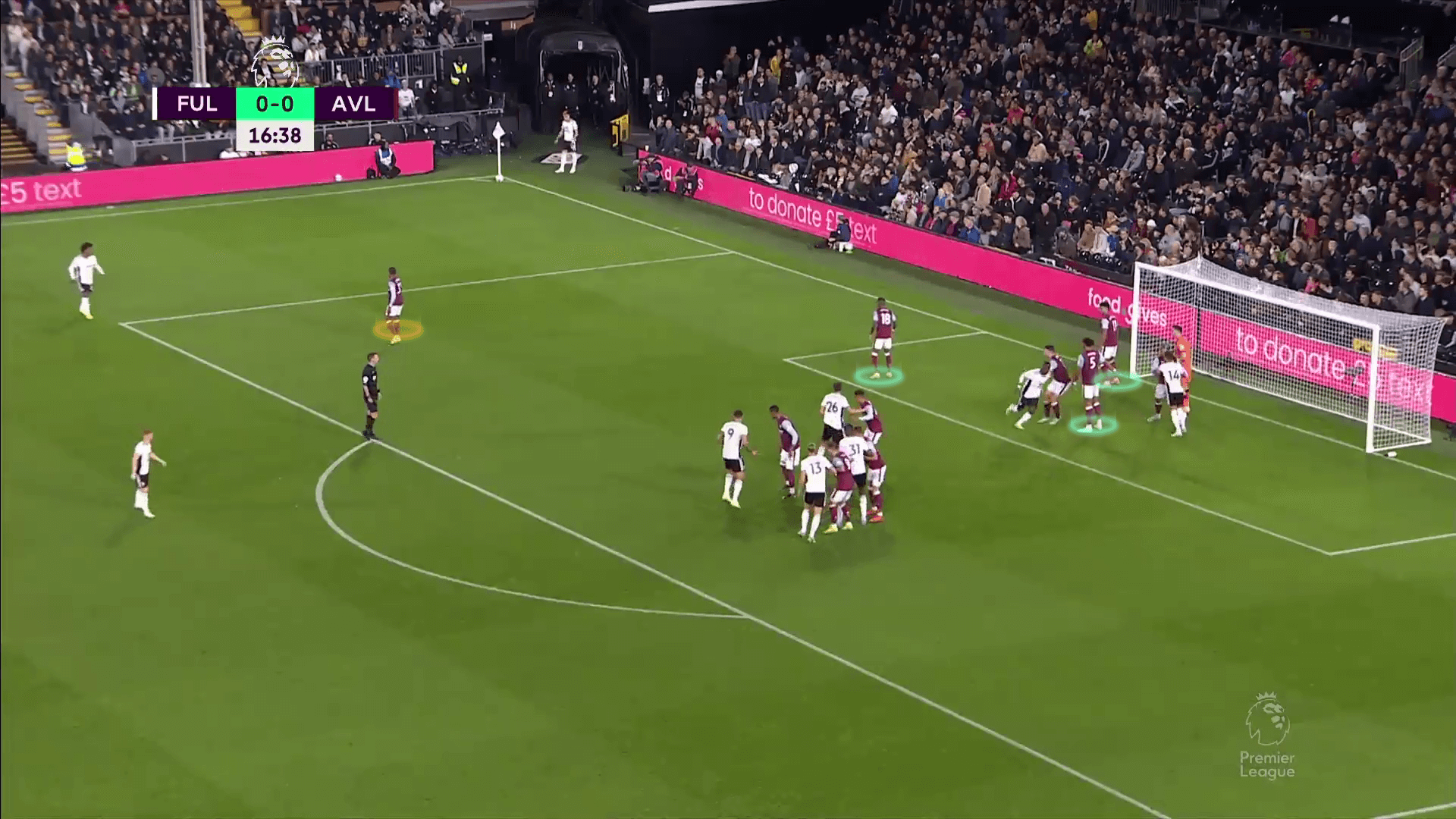
Fulham have placed two players inside the six-yard box, four players in a pack — which helps some of them act as screens — and three players in the rebound zone.
When the taker starts moving, Mitrović goes to the far post via a curved run.
Meanwhile, João Palhinha (at the front of the pack with a yellow arrow) goes to the near post, dragging his marker with him.
The remaining two of the pack act as a screen to help Mitrović escape from his man-marker.
This double screen or traffic helps a lot, and they also add the same orientation problem caused by the marker.
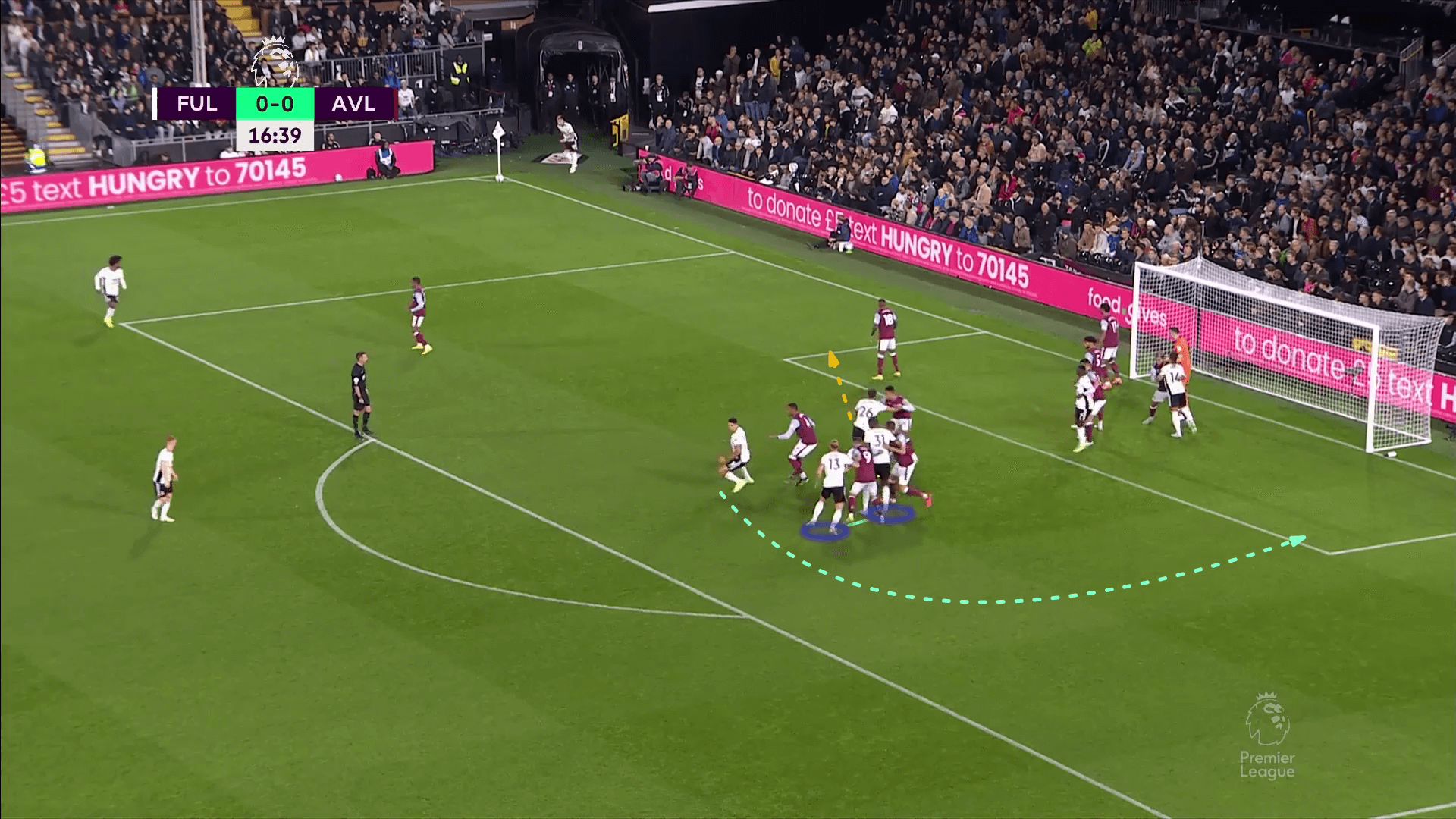
In the first photo, the player highlighted in yellow blocks his marker to prevent him from going to the far post to make the targeted area empty for Mitrović; the two players highlighted in green act as a screen, and the player with a blue arrow goes to block Mitrović’s marker in case he escaped from the first screen as shown in the second photo.
Then, Mitrović headed the ball, but Aston Villa’s defender cleared it at the last moment.
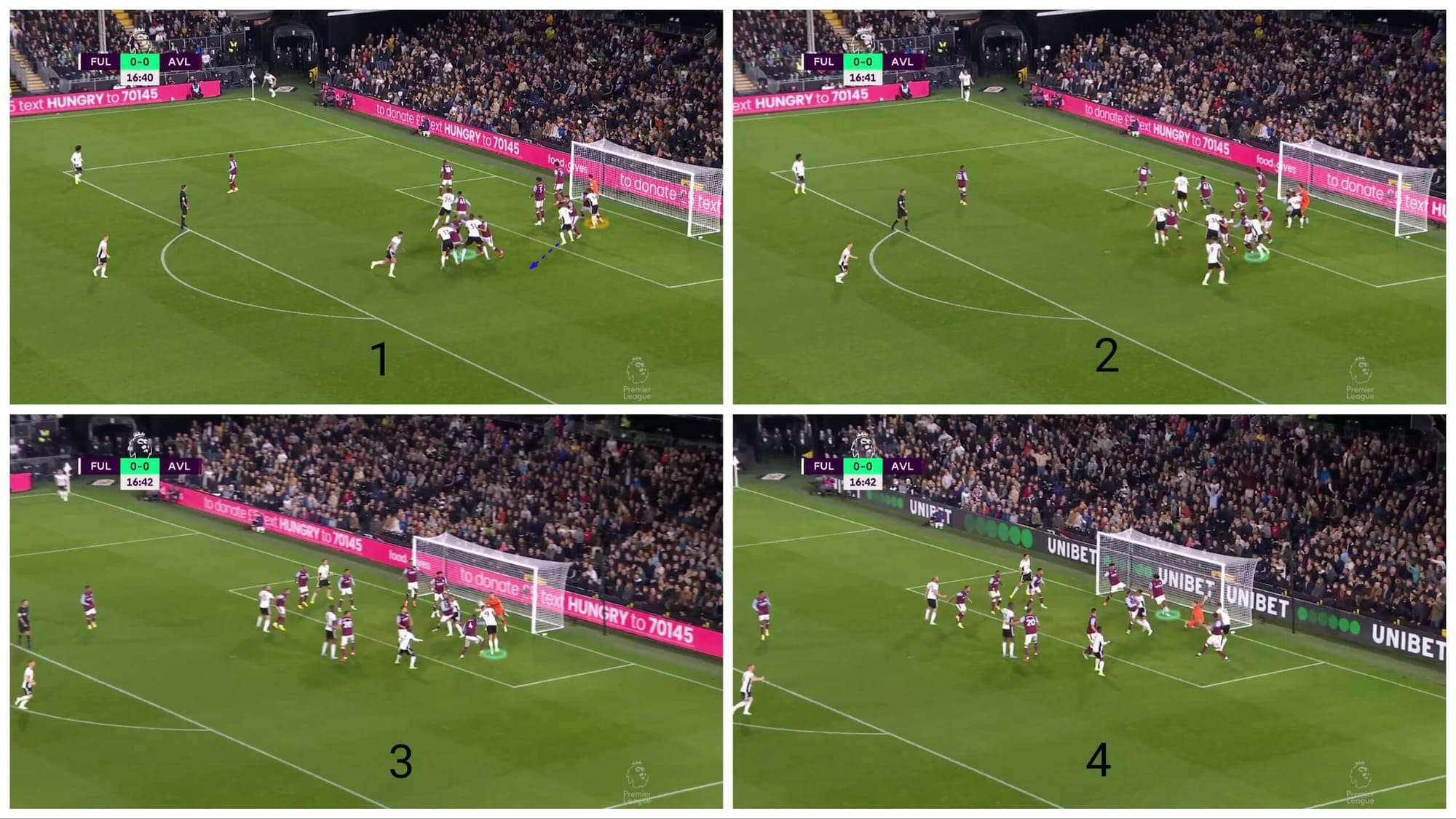
Conclusion
In this analysis, we have illustrated the various techniques and strategies for creating a screen using separation, orientation problems, and big packs to cause traffic.
These techniques shown in this set-piece analysis aim to be effective while avoiding fouls.

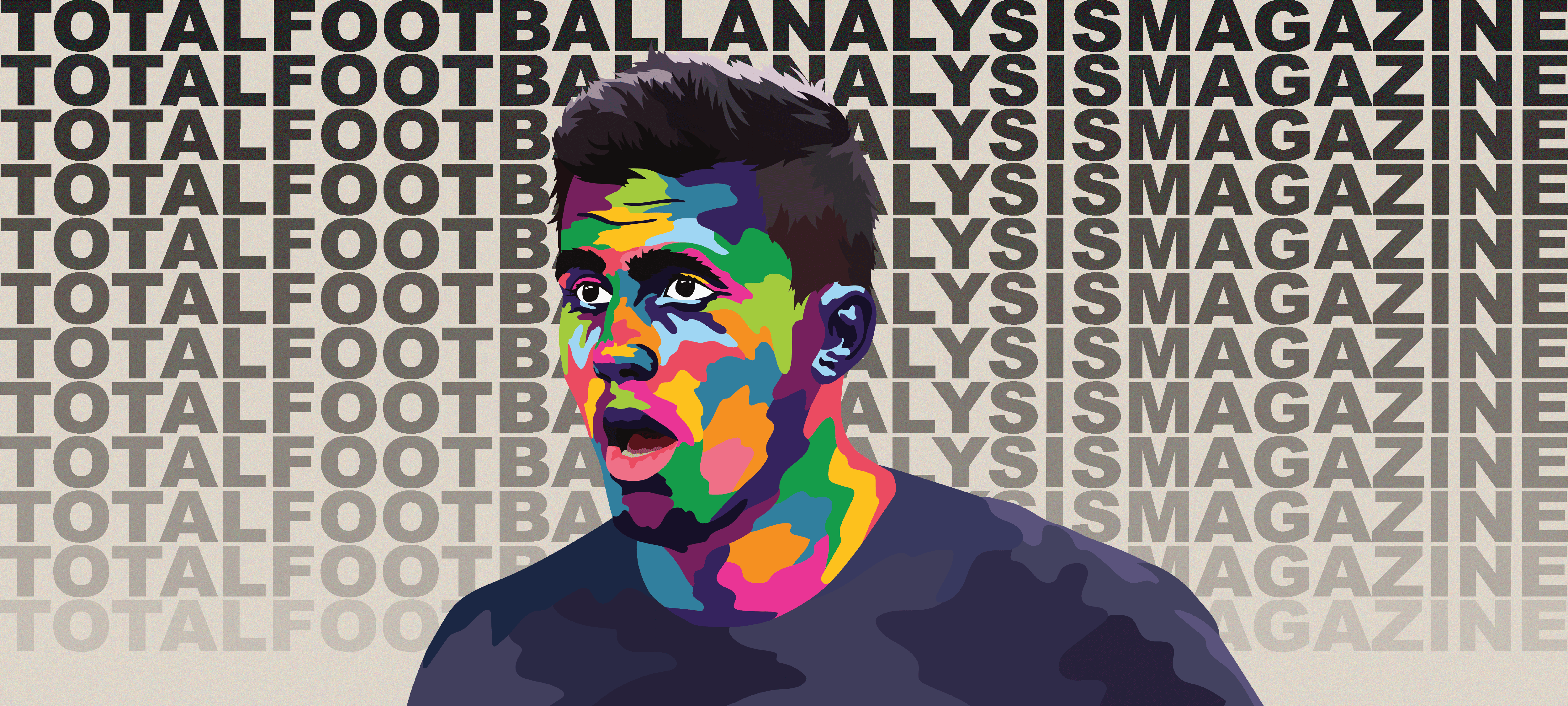




Comments